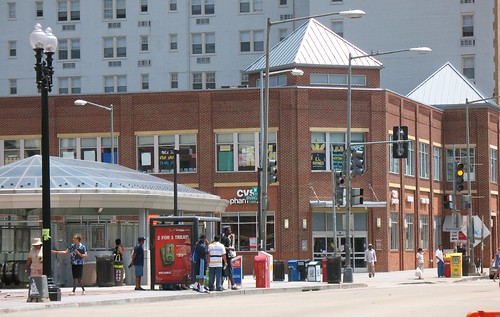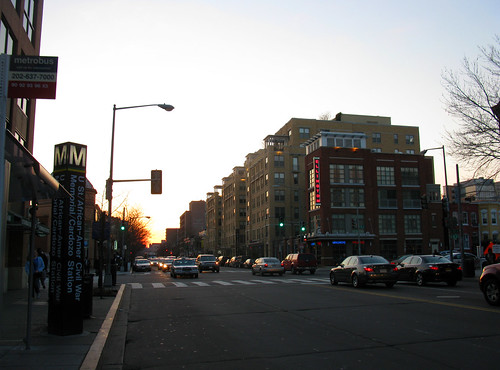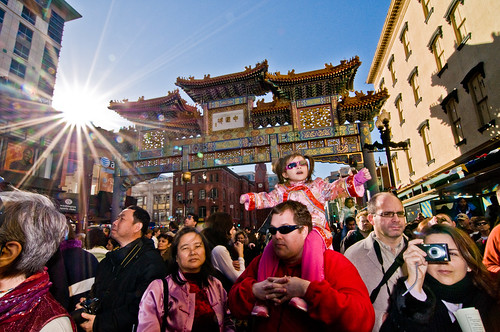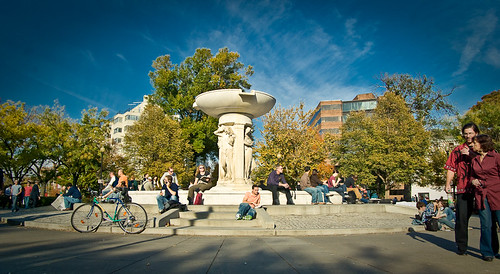
‘Woodley Station’
courtesy of ‘Tyrannous’
Hi, and welcome to a new feature called Five Favorites. Our reader Jay suggested ranking favorite places in DC, and I’m going to start with five favorite Metro stations. These are stations that are the best examples of vibrant, walkable, urban, mixed-use places in the District. These are the Metro stations that you could emerge from at any time, and there’d always be plenty of people around. This list is a mix of subjective factors and measurable data, so feel free to disagree and tell me which of your favorites I missed.
Number 5: Woodley Park/Adams Morgan. Ok, we all know that it’s annoying to have to walk across the bridge to get from the Metro station to the heart of Adams Morgan, but still– this Metro station is always full of people emerging from the ridiculously long escalators. The Connecticut Avenue strip where you emerge from the Metro station is full of some great restaurants, and the 10-minute walk across the bridge to 18th Street puts you in the middle of it all.
The Adams Morgan neighborhood itself is a diverse, multi-cultural neighborhood with restaurants, bars, shops, and corner stores, and cute rowhouses and apartments mixed in. While this stop just barely made it into the top five because of the distance to Adams Morgan itself, the vibrant, constantly-moving atmosphere of the area and the busy-ness of the Metro itself (residents and commuters in the mornings, people out on dates in the evenings, college students in the late evenings) make it one of the best mixed-use Metro stations in the city. Walk Score: 95. The Woodley Park Metro station has an average daily ridership of 8,000.

‘Columbia Heights Metro Station and CVS’
courtesy of ‘Mr. T in DC’
Number 4: Columbia Heights. Now here’s a neighborhood that wouldn’t have even been close to this list five years ago. But today, the Columbia Heights area is a major commercial center in the city. The DC USA development that opened in 2008 and the Tivoli redevelopment just up the street are major attractions, and the new housing that has been built right on top of the Metro has created a true mixed use community.
The Columbia Heights neighborhood has a mix of new development and older residential areas, of young new residents and life-long DC residents, all mixed together in a relatively small area. On any given evening, the plaza above the Metro station is full of kids playing, people carrying Target bags, older residents people-watching, and commuters returning from work. Walk Score: 92. The Columbia Heights Metro has an average daily ridership of 7,300.

‘2009 03 20 – 2911 – Washington DC – U St at 12th St’
courtesy of ‘thisisbossi’
Number 3: U Street. Here’s another redevelopment success story. U Street was decimated after the 1968 riots, and up until the 1990s, parts of the area were abandoned. But the Metro station opened in 1991, and developers saw an opportunity to build thousands of condo units in a commercial corridor right next to the Metro and voila! Today U Street is a vibrant, beautiful neighborhood, known for its local businesses and restaurants, concert venues, and shops.
The surrounding area includes the Shaw and Logan Circle neighborhoods, making U Street a highly walkable district. And with the mix of condos, rowhouses, restaurants, bars, concert venues, and shops, there’s always a lot of activity in the corridor. And who could forget the amazing street activity on election night in U Street? Walk Score: 97. The U Street Metro station has an average daily ridership of 5,400.

‘Chinatown – Celebrate – 2-1-09’
courtesy of ‘mosley.brian’
Number 2: Gallery Place-Chinatown. Yet another urban revitalization success story. This downtown area was generally perceived as a dangerous part of town with nothing much to offer about 15 years ago. But then the MCI Center opened in 1997, and the neighborhood turned around. Restaurants lined 7th Street, major retailers moved in, a huge movie theater opened, and finally, a bunch of condos and apartments were built. Seemingly overnight, this area became the heart of downtown DC, due in large part to the Metro station and MCI Center.
The Penn Quarter neighborhood is now one of the most sought-after neighborhoods in the city, and the major retail and entertainment attractions draw people from across the region. The Metro station plaza near 7th and H Streets is always a hub of activity, and the mix of residents, bars, restaurants, and entertainment keep this area alive at any hour of the day. Walk Score: 97. The seventh busiest station overall, Gallery Place-Chinatown has an average daily ridership of over 20,000.

‘dupont circle-6’
courtesy of ‘dr_kim_veis [”o ]’
Number 1: Dupont Circle. Here’s a neighborhood that hasn’t undergone the huge changes that many of these other neighborhoods have. Dupont Circle has been a major hub in DC since the 1870s, and the Metro station that opened in 1977 made the area even more attractive. The station’s two entrances are right in the middle of the commercial development on Connecticut Avenue, and within a short walk to offices, rowhouses, shops, restaurants, bars, and parks. The neighborhood is a historic district, and the residential blocks that intersect with Connecticut are just beautiful.
The Dupont Circle neighborhood is a mix of just about every use you could imagine within a 5-block radius. The Circle itself is filled with young people with dogs, families with kids, homeless people playing chess, and lots of people just hanging out and people-watching. Every day of the year, Dupont Circle is full of people walking around and milling about. And though I think that both Gallery Place and Dupont Circle should be tied in terms of vibrant, walkable places, there is one factor that pushes Dupont up to first place: the brass band that plays outside the south entrance. It is just everything that is wonderful about a vibrant urban neighborhood, with people from all backgrounds stopping and listening to music and just hanging out. Walk Score: 98. The fourth busiest station overall, Dupont Circle has an average daily ridership of almost 24,000.
So there’s the list: highly subjective, with a little bit of data thrown in. Which vibrant, mixed-use stations in the District did I miss?
Nothing outside of NW?
You know, I was thisclose to making Eastern Market #5, but I felt like it only really had the great active, pedestrian vibe on weekend afternoons. I lived there a few years back and it was just dead after 10 PM.
The other non-NW places that I considered were Navy Yard (but only during baseball game days do you get the mix of residents, office workers, and baseball fans) and Union Station (but there’s not a great mix of uses there, and while you do get some people hanging around, it’s mostly people trying to get somewhere).
I definitely didn’t mean for it to be an entirely-NW list, though. It just happens that a lot of the mixed use development has happened in that quadrant.
Just wondering, if not Metro Center, what is the busiest metro station? Smithsonian?
Nothing on the blue or orange line?
@Brendan Union Station is the busiest, followed by Metro Center, Farragut North, Dupont, and Farragut West. Believe it or not, Smithsonian barely cracks the top 20, at number 18.
@Tim If this was a top 10 list, I’d definitely include both Eastern Market and Foggy Bottom. I limited it to DC only, so that takes out the Rosslyn-Ballston corridor and Alexandria. Which orange/blue stations were you thinking of?
What about Van Dorn Street?
Pingback: Five Favorites: Circles, Triangles, and Squares » We Love DC